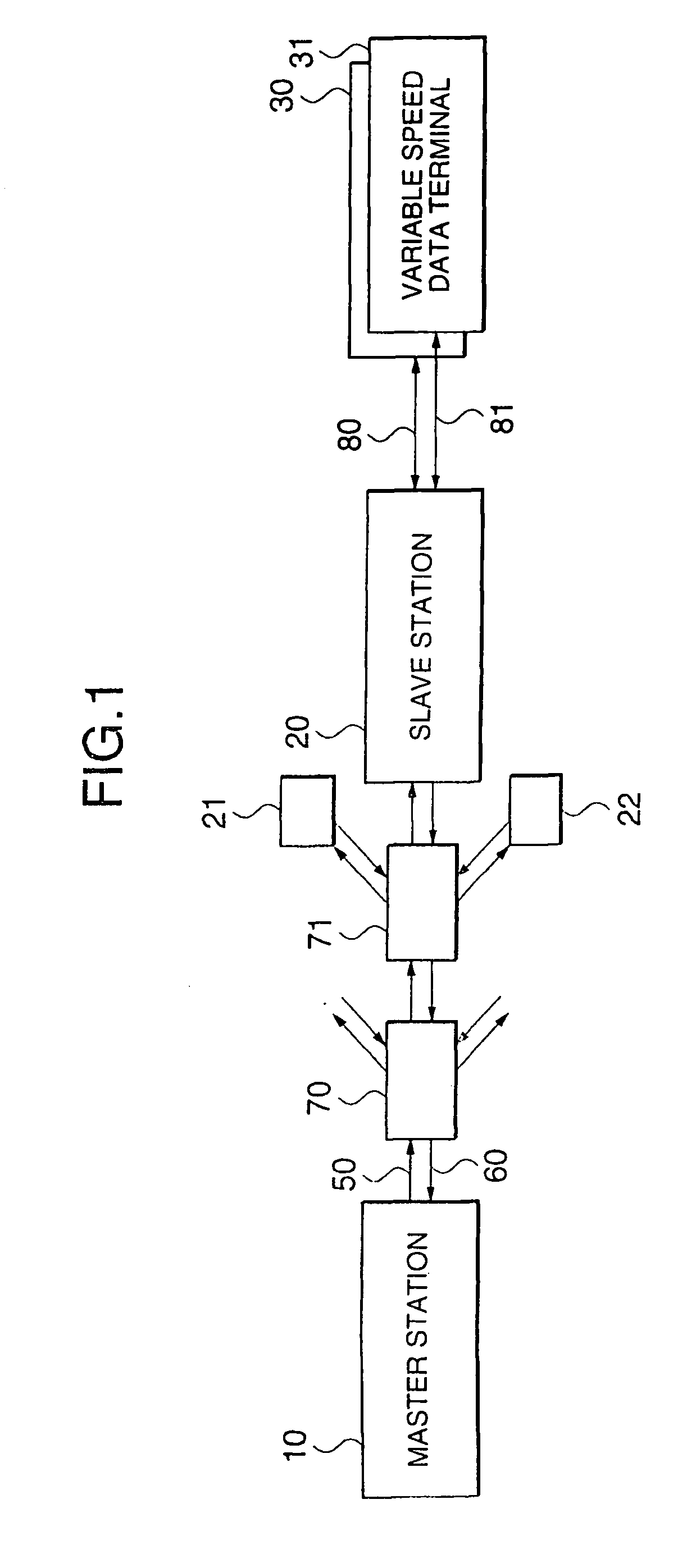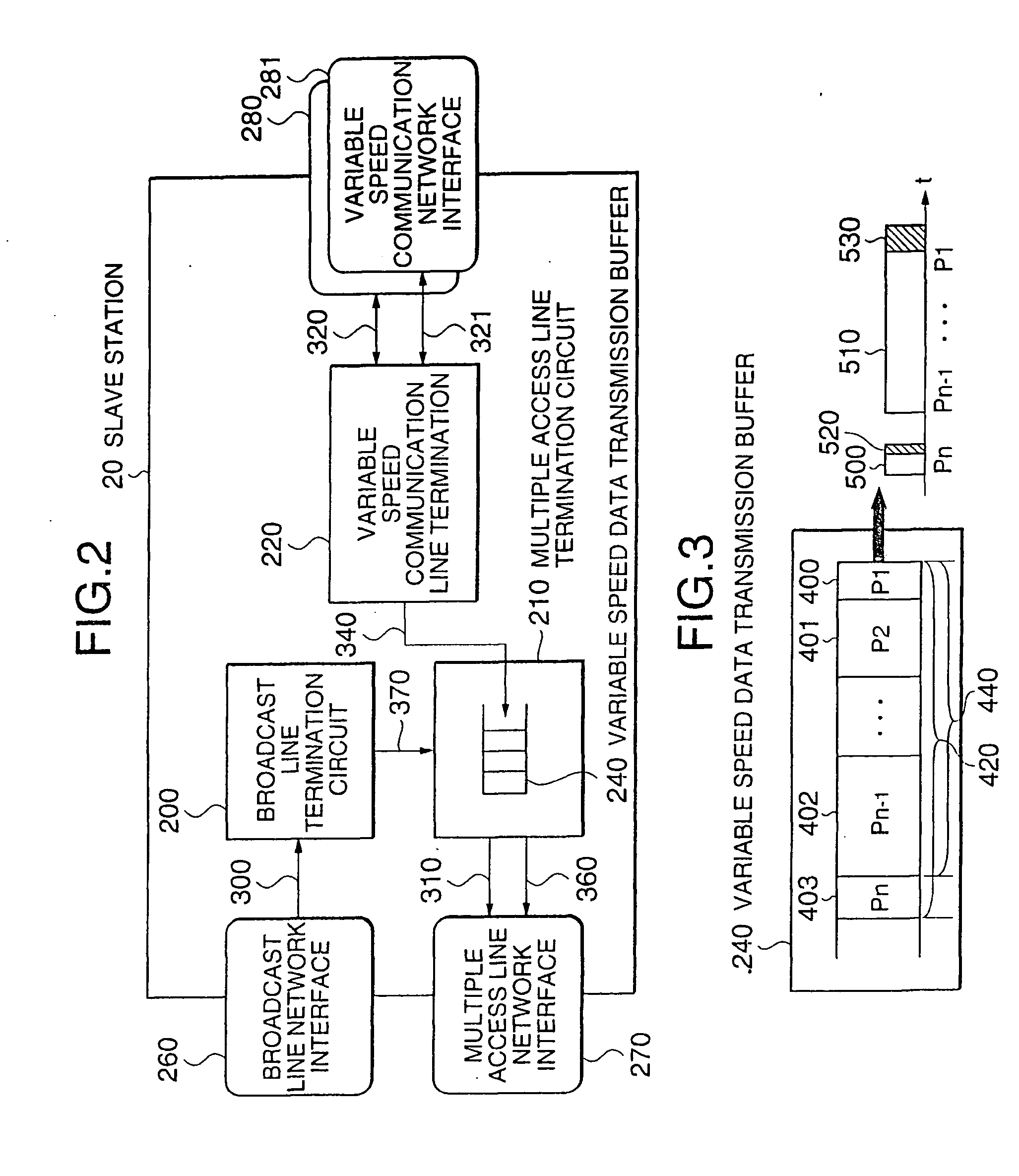Multiple access communication system and data transceiver
a communication system and multi-access technology, applied in multiplex communication, synchronisation arrangement, wireless communication, etc., can solve the problems of increasing the length of time that other slave stations must wait until transmitting transmission data, reducing the utilization rate of multiple access lines, and increasing the delay of transmission data, which is required in real time, to achieve high utilization rate
- Summary
- Abstract
- Description
- Claims
- Application Information
AI Technical Summary
Benefits of technology
Problems solved by technology
Method used
Image
Examples
first embodiment
[0050] A first embodiment of the present invention will be described in the following, with reference to the drawings.
[0051]FIG. 1 is a block diagram showing a multiple access communication system of this embodiment. In this drawing, a plurality of slave stations 20, 21 and 23 receive data and control information from a master station 10 through a broadcast line 50. The master station 10 receives data packets and control information packets from the plurality of slave stations through a multiple access line 60. Also, the slave station 20 is connected to a variable speed data terminals 30 and 31 through variable speed communication lines 80 and 81 respectively.
[0052]FIG. 2 is a block diagram showing the above-described slave station in detail. A broadcast line termination circuit 200 receives data from the master station, while a multiple access line termination circuit 210 transmits data to the master station. A variable speed communication line termination circuit 220 transmits a...
second embodiment
[0056] Next, a second embodiment of the present invention will be described with reference to FIG. 1, FIG. 2 and FIG. 4.
[0057]FIG. 4 is an example of the format of an uplink transmission data packet according to the second embodiment. When uplink transmission data packets P1, P2, . . . Pn−1, Pn are held in the variable speed data transmission buffer 240, the multiple access line termination circuit 210 reads out an internally held transmission condition. When an upper limit value for a concatenated data packet size has been set in the transmission condition, the multiple access line termination circuit 210 performs concatenating for only a concatenated data packet size 430 that does not exceed the upper limit value, adds a concatenated transmission overhead 530 to the concatenated transmission data packet 510 and transmits a resultant packet to the master station 10 through the multiple access line network 60.
[0058] For example, assuming that the upper limit to the concatenated da...
third embodiment
[0059] Next, a third embodiment of the present invention will be described with reference to FIG. 1, FIG. 2 and FIG. 5.
[0060]FIG. 5 is an example of the format of an uplink transmission data packet of this third embodiment. When uplink transmission data packets 400, 401, 402 and 403 shown as P1, P2, . . . Pn−1, Pn are held in the variable speed data transmission buffer 240, the multiple access line termination circuit 210 reads out a transmission condition for packet concatenation. Processing is set for the case where a concatenated transmission overhead size meeting the transmission condition is smaller than the total size of individual transmission overheads.
[0061] In the case of individual transmission, transmission overheads 520, 521, 522 and 523 shown as H1, H2 . . . Hn are individually added to uplink transmission data packets 400, 401, 402 and 403 and are transmitted. Also, in the case of concatenated transmission, the uplink transmission data packets 400, 401, 402 and 403 ...
PUM
 Login to View More
Login to View More Abstract
Description
Claims
Application Information
 Login to View More
Login to View More - R&D
- Intellectual Property
- Life Sciences
- Materials
- Tech Scout
- Unparalleled Data Quality
- Higher Quality Content
- 60% Fewer Hallucinations
Browse by: Latest US Patents, China's latest patents, Technical Efficacy Thesaurus, Application Domain, Technology Topic, Popular Technical Reports.
© 2025 PatSnap. All rights reserved.Legal|Privacy policy|Modern Slavery Act Transparency Statement|Sitemap|About US| Contact US: help@patsnap.com



